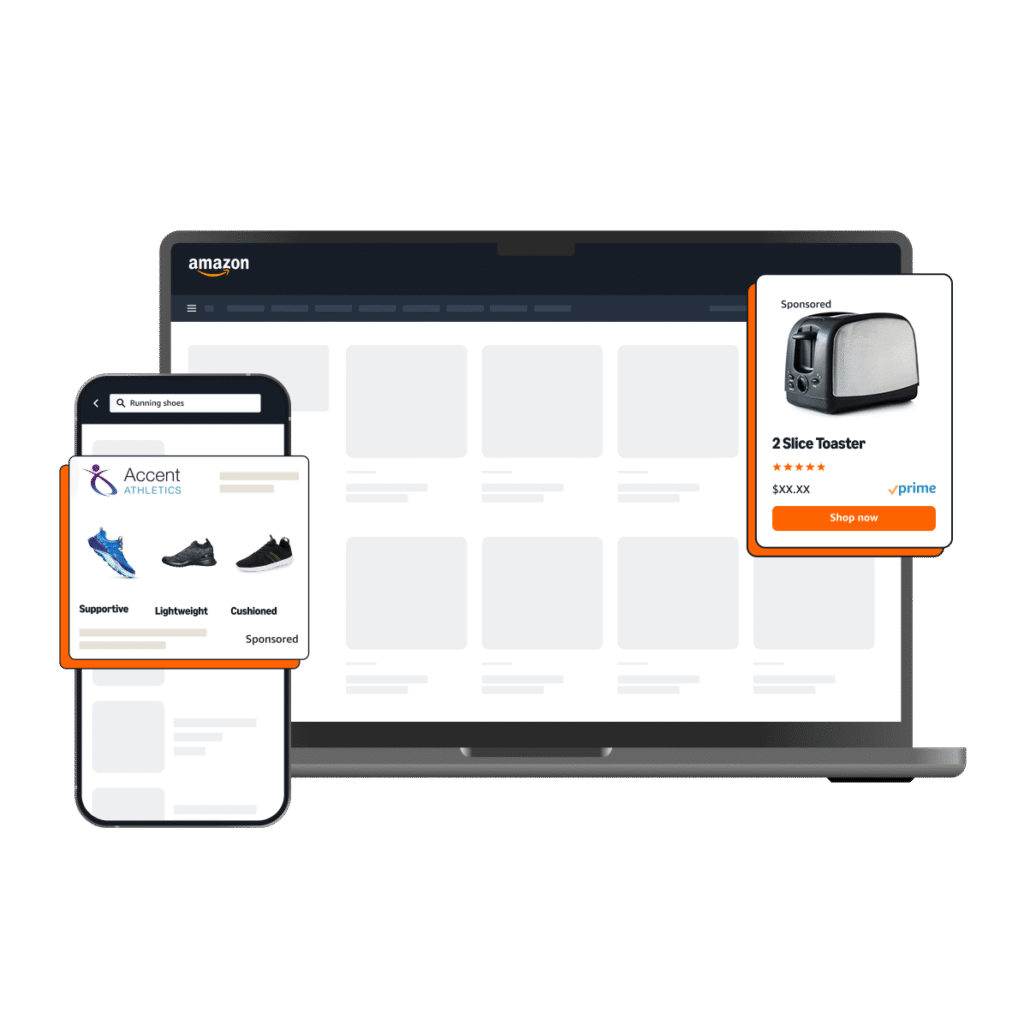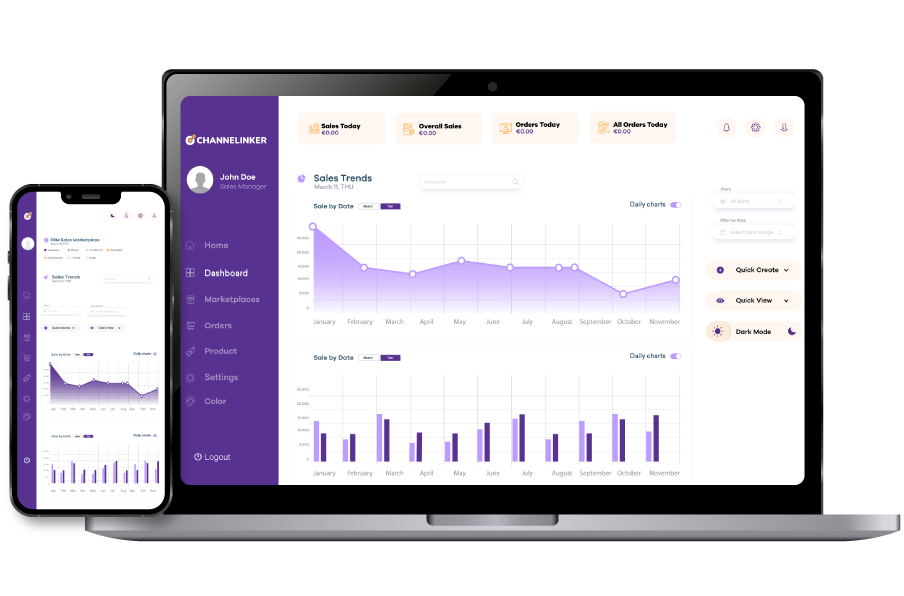Advertising on Amazon: The Ultimate Guide for Amazon Sellers

Advertising on Amazon efficiently can enhance product visibility, increase sales volume, and build strong brand recognition. Amazon offers a powerful suite of advertising solution; each designed for different campaign goals and growth stages. In this guide, we explore not only Sponsored Products and Sponsored Brands, but also Sponsored Display, Amazon DSP (Demand-Side Platform), and Stores, with detailed strategies for campaign setup, targeting, budgeting, bidding, and performance measurement.
Overview of Amazon Advertising
Amazon Advertising provides a comprehensive ecosystem of solutions for brands and sellers to connect with customers throughout the entire shopping journey. Sponsored Products and Sponsored Brands are the most commonly used by marketplace sellers, but advanced advertisers also benefit from Sponsored Display and Amazon DSP for reaching audiences outside the traditional search and product page environments.
- Sponsored Products promote individual listings in search results and on product pages.
- Sponsored Brands allow for branded messaging with logos, headlines, and multi-product displays.
- Sponsored Display enables audience retargeting and competitor targeting.
- Amazon DSP facilitates automated buying of display, audio, and video ads across Amazon properties and external sites.
- Amazon Stores provide a multi-page branded storefront to consolidate customer experience and measure brand-level metrics.
Choosing the right mix depends on your budget, objectives (e.g. conversions, brand awareness, or retargeting), and catalog size.
Sponsored Products vs Sponsored Brands
Sponsored Products are ideal for promoting individual ASINs. These ads are triggered by keywords or targeted ASINs and are designed to appear directly where shoppers are most likely to click—on search results or product detail pages. They offer cost-effective exposure and help win the Buy Box. Because they closely resemble organic listings, they maintain high trust and typically drive strong conversion rates. New product launches, clearance campaigns, or seasonal promotions often benefit from Sponsored Products.
Sponsored Brands, on the other hand, are used for upper-funnel marketing strategies. These ads appear above search results and showcase your brand logo, a custom message, and multiple products. They are effective for brand discovery and for introducing product bundles or variations. Sponsored Brands can be linked to your Amazon Store or to a curated product landing page, allowing sellers to guide shoppers through a storytelling experience. When paired with branded keyword targeting, these ads also help defend your brand space from competitor takeovers.
To optimize both, run them in parallel with complementary targeting strategies—use Sponsored Products for precision and Sponsored Brands for brand reinforcement.

Sponsored Display Ads and Amazon DSP
Sponsored Display Ads are versatile placements that reach audiences both on and off Amazon. They target shoppers who viewed your products but didn’t purchase, browsed similar categories, or interacted with related interests. These ads help you re-engage high-intent audiences and nurture product familiarity. Sponsored Display is ideal for remarketing strategies and boosting the visibility of complementary items.
Amazon’s Demand-Side Platform (DSP) enables advertisers to buy video, display, and audio ads programmatically, offering deep audience segmentation. It is more advanced than Sponsored Display, allowing for audience overlap exclusion, frequency caps, and reach expansion beyond Amazon’s properties. DSP is best suited for brands with a higher budget looking to implement full-funnel campaigns, particularly those focusing on brand lift, customer retention, and expanding beyond Amazon’s marketplace.
Both Sponsored Display and DSP serve critical roles in customer reactivation and external audience acquisition, and they become essential tools in scaling a mature advertising strategy.
Amazon Stores: Brand-Building Hub
An Amazon Store provides a curated, immersive shopping experience for your customers. With drag-and-drop widgets, sellers can showcase brand stories, product categories, bestsellers, and seasonal collections. These stores help increase average order value (AOV) by encouraging cross-selling and longer browsing sessions.
By directing Sponsored Brands and Display Ads to an Amazon Store rather than a product detail page, advertisers see increased session time and improved conversion rates. Moreover, Amazon Store analytics provide insights into traffic sources, dwell time, and unit sales per visit—helpful metrics for assessing brand-building ROI.
Campaign Setup and Targeting Options
Begin your campaign setup by determining clear objectives: is the campaign focused on launching a new product, increasing market share, or retargeting past viewers? Based on the goal, choose your campaign type and structure your campaigns accordingly.
Amazon offers robust targeting mechanisms:
- Keyword targeting: Match customer queries using exact, phrase, or broad match types.
- Product targeting: Display your ads on specific ASINs, competitor listings, or within product categories.
- Audience targeting (Sponsored Display and DSP): Reach audiences based on browsing history, interests, or lifestyle segments.
Use automatic campaigns to discover high-performing keywords and ASINs, then refine performance with manual campaigns. Negative keyword additions help reduce waste. Segment campaigns by product category or lifecycle stage to maintain budget control and precise analytics.
Keyword and ASIN targeting tools like Helium 10 and Jungle Scout can aid in building effective targeting lists.
Budgeting and Bidding Strategies
Amazon allows you to set campaign-level daily budgets, ad group level default bids, and specific bid adjustments based on ad placement.
Establish a learning phase budget to gather data, especially during new launches or seasonal events. During this phase, prioritize data over profitability. As you gather insight, shift towards ROI-based optimization.
Amazon’s bidding options include:
- Dynamic bids – down only: Safely lower bids when conversion is unlikely.
- Dynamic bids – up and down: Automatically raise or lower bids based on real-time conversion likelihood.
- Fixed bids: Stable control, good for testing purposes.
Boost top-of-search placement by adjusting bid multipliers, especially for high-converting keywords or premium products.
Measuring Ad Performance: Going Beyond ACoS
ACoS (Advertising Cost of Sale) helps determine the efficiency of your ads by comparing spend to attributed ad revenue. But ACoS alone does not reflect your overall business health.
Enter TACoS (Total Advertising Cost of Sale), which considers total revenue (including organic sales). A low and declining TACoS suggests your ads are helping lift your organic presence. Conversely, rising TACoS with flat or declining sales may signal overdependence on ads or inefficient campaigns.
Use the following performance indicators:
- CTR (Click-Through Rate): Indicates relevance
- Conversion rate: Measures post-click effectiveness
- ACoS and TACoS: For budget efficiency and business impact
- ROAS: Tracks return on ad spend
- New-to-brand sales: Important for brand-building campaigns
Tools like Channelinker Analytics help visualize cross-campaign performance and calculate TACoS trends over time.

Advanced PPC and Targeting Strategies
As your campaigns scale, advanced strategies become crucial. Here are some that differentiate high-performing sellers:
- Dayparting: Use hourly performance data to increase bids during high-converting hours.
- Negative keyword harvesting: Add irrelevant terms as negatives to reduce wasted spend.
- Product defense: Run ads on your own listings to block competitor ads.
- Audience layering: Combine demographic and interest targeting for more precise reach (DSP only).
- Branded vs non-branded segmentation: Helps measure brand equity vs competitive conquesting.
- Video placements: Sponsored Brands Video ads autoplay on search results and often offer lower CPCs with higher engagement.
Continual testing and data-backed optimizations are essential. Weekly bid and budget adjustments ensure campaigns remain aligned with shifting trends.
Integrating with Pricing and Promotion Strategy
Advertising efforts work best when aligned with pricing and promotion strategies. As covered in our Pricing Strategies and Promotions on Amazon article, promotions such as coupons, Lightning Deals, and Prime-exclusive discounts create additional demand levers.
Here’s how to integrate the two:
- Coordinate Sponsored Product ads during promotions to maximize visibility
- Run Sponsored Brands highlighting promotional collections or discounted bundles
- Leverage Display Ads to retarget customers who clicked but didn’t purchase a promoted product
Combining pricing flexibility with advertising precision results in higher CTRs, stronger conversion rates, and elevated ranking performance during key events.

Frequently Asked Questions
Which ad types should I start with as a new seller?
Start with Sponsored Products for core exposure. Use auto campaigns to gather keyword data and transition to manual targeting as your performance data grows.
Is Amazon DSP suitable for smaller brands?
While DSP is more complex and typically budget-intensive, Amazon has launched managed services for emerging brands. If brand awareness and remarketing are part of your roadmap, DSP is worth exploring.
How often should I review my campaigns?
Review campaign performance weekly. Make bid and targeting adjustments biweekly and conduct deep optimization monthly.
What is a healthy TACoS benchmark?
Varies by category, but 6-10% is generally considered efficient. Monitor trend lines rather than static numbers to gauge progress.
Conclusion: Mastering Amazon Advertising in 2025
Amazon Advertising continues to evolve, and success now requires more than simple keyword targeting. Sellers must combine data-driven tactics with full-funnel thinking. From Sponsored Products to DSP and from video ads to pricing coordination, advertising on Amazon demands strategic planning, budget flexibility, and continuous refinement.
To manage these efforts across multiple regions and platforms, tools like Channelinker help unify campaign insights, listing management, and pricing control into one interface.
Related Articles
Pricing Strategies and Promotions on Amazon
Amazon Inventory Management and Fulfillment
Optimizing Amazon Product Listings
External Resources
Amazon Seller Central Ad Tools
Amazon Seller University Advertising Course
Start building high-performing, data-backed advertising campaigns today—and make every click count.


